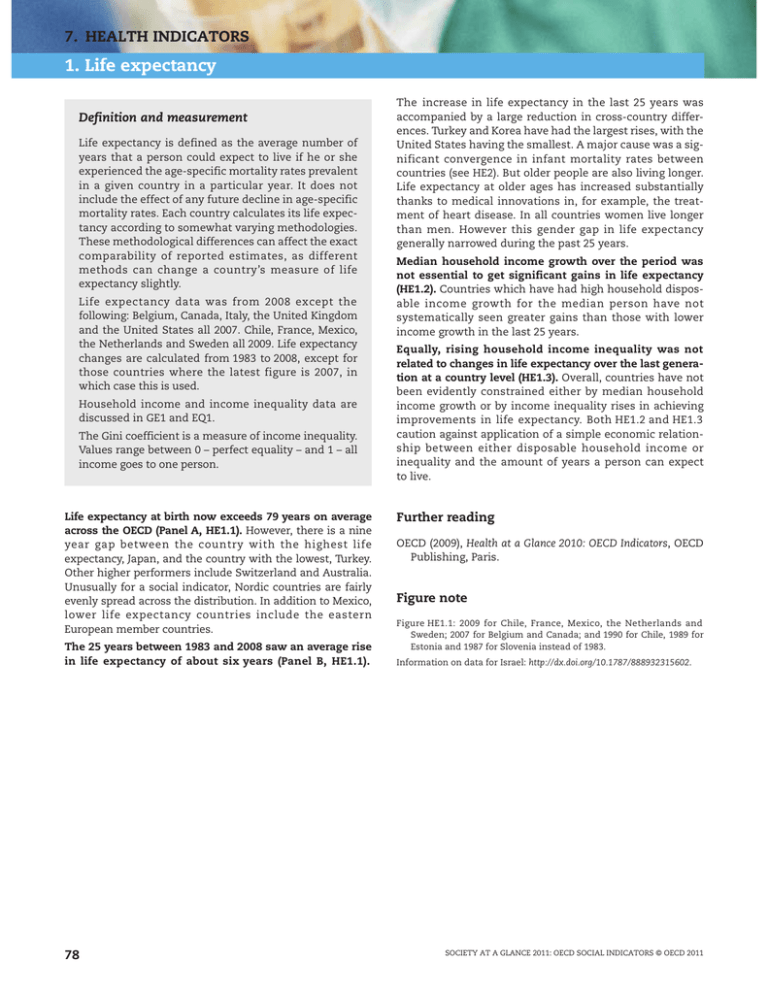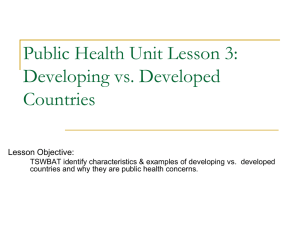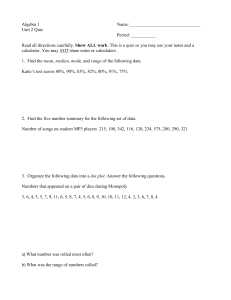1. Life expectancy
advertisement

7. HEALTH INDICATORS 1. Life expectancy Definition and measurement Life expectancy is defined as the average number of years that a person could expect to live if he or she experienced the age-specific mortality rates prevalent in a given country in a particular year. It does not include the effect of any future decline in age-specific mortality rates. Each country calculates its life expectancy according to somewhat varying methodologies. These methodological differences can affect the exact comparability of reported estimates, as different methods can change a country’s measure of life expectancy slightly. Life expectancy data was from 2008 except the following: Belgium, Canada, Italy, the United Kingdom and the United States all 2007. Chile, France, Mexico, the Netherlands and Sweden all 2009. Life expectancy changes are calculated from 1983 to 2008, except for those countries where the latest figure is 2007, in which case this is used. Household income and income inequality data are discussed in GE1 and EQ1. The Gini coefficient is a measure of income inequality. Values range between 0 – perfect equality – and 1 – all income goes to one person. Life expectancy at birth now exceeds 79 years on average across the OECD (Panel A, HE1.1). However, there is a nine year gap between the country with the highest life expectancy, Japan, and the country with the lowest, Turkey. Other higher performers include Switzerland and Australia. Unusually for a social indicator, Nordic countries are fairly evenly spread across the distribution. In addition to Mexico, lower life expectancy countries include the eastern European member countries. The 25 years between 1983 and 2008 saw an average rise in life expectancy of about six years (Panel B, HE1.1). 78 The increase in life expectancy in the last 25 years was accompanied by a large reduction in cross-country differences. Turkey and Korea have had the largest rises, with the United States having the smallest. A major cause was a significant convergence in infant mortality rates between countries (see HE2). But older people are also living longer. Life expectancy at older ages has increased substantially thanks to medical innovations in, for example, the treatment of heart disease. In all countries women live longer than men. However this gender gap in life expectancy generally narrowed during the past 25 years. Median household income growth over the period was not essential to get significant gains in life expectancy (HE1.2). Countries which have had high household disposable income growth for the median person have not systematically seen greater gains than those with lower income growth in the last 25 years. Equally, rising household income inequality was not related to changes in life expectancy over the last generation at a country level (HE1.3). Overall, countries have not been evidently constrained either by median household income growth or by income inequality rises in achieving improvements in life expectancy. Both HE1.2 and HE1.3 caution against application of a simple economic relationship between either disposable household income or inequality and the amount of years a person can expect to live. Further reading OECD (2009), Health at a Glance 2010: OECD Indicators, OECD Publishing, Paris. Figure note Figure HE1.1: 2009 for Chile, France, Mexico, the Netherlands and Sweden; 2007 for Belgium and Canada; and 1990 for Chile, 1989 for Estonia and 1987 for Slovenia instead of 1983. Information on data for Israel: http://dx.doi.org/10.1787/888932315602. SOCIETY AT A GLANCE 2011: OECD SOCIAL INDICATORS © OECD 2011 7. HEALTH INDICATORS 1. Life expectancy HE1.1. Life expectancy has increased remarkably in OECD countries Panel A. Life expectancy at birth in 2008 or latest year ( ) Panel B. Rise in life expectancy between 1983 and 2008 (in years) Japan Switzerland Australia Italy Sweden Iceland France Spain Israel Canada Luxembourg Norway Austria New Zealand Netherlands Germany Greece Finland Ireland Korea Belgium United Kingdom Portugal OECD Chile Denmark Slovenia United States Czech Republic Poland Mexico Slovak Republic Estonia Hungary Turkey 82.7 82.2 81.5 81.5 81.4 81.3 81.2 81.2 81.1 80.7 80.6 80.6 80.5 80.4 80.3 80.2 80.0 79.9 79.9 79.9 79.8 79.7 79.3 79.3 78.8 78.8 78.8 77.9 77.3 75.6 75.3 74.8 73.9 73.8 73.6 70.8 67.8 63.7 80 75 70 65 4.2 6.4 5.1 6.6 4.5 7.1 4.3 7.4 6.7 4.0 6.4 4.6 5.5 6.8 12.5 5.8 5.4 6.9 6.0 6.3 4.3 6.7 3.3 6.6 4.5 6.7 4.2 3.8 4.7 13.9 60 6.6 8.7 14.1 0.2 7.5 0 HE1.2. No relationship between rising life expectancy and income growth 5 10 15 HE1.3. No relationship between rising life expectancy and income inequality changes Rise in life expectancy between 1983 and 2008 (in years) 14 Rise in life expectancy between 1983 and 2008 (in years) 14 TUR 13 6.7 4.8 China Brazil Indonesia Russian Federation India (51.5) South Africa (-7.0) 73.1 72.4 85 5.7 6.0 6.0 TUR 13 12 12 11 11 10 10 9 9 8 8 CZE ITA MEX FRA NZL OECD BEL DEU FIN JPN 7 6 5 HUN CAN 4 SWE DNK USA AUT LUX LUX AUS GBR GRC NOR NLD 7 PRT IRL ESP 3 -1 0 1 2 3 4 5 Average annual change in median household income between mid-80s and mid-2000s (%) FRA 6 5 IRL MEX BEL ESP GRC -0.05 CZE ITA PRT OECD DEU JPN GBR SWE HUN DNK NOR CAN NLD USA 4 3 -0.10 AUT 0 NZL FIN 0.05 0.10 Change in Gini between mid-80s and mid-2000s Source: OECD (2010), OECD Health Data 2010, OECD Publishing, Paris (www.oecd.org/health/healthdata), and OECD Income Distribution and Poverty Database (www.oecd.org/els/social/inequality). For non-OECD countries: United Nations Population Database, World Population Prospects: The 2008 Revision (http://esa.un.org/UNPP). 1 2 http://dx.doi.org/10.1787/888932381969 SOCIETY AT A GLANCE 2011: OECD SOCIAL INDICATORS © OECD 2011 79


